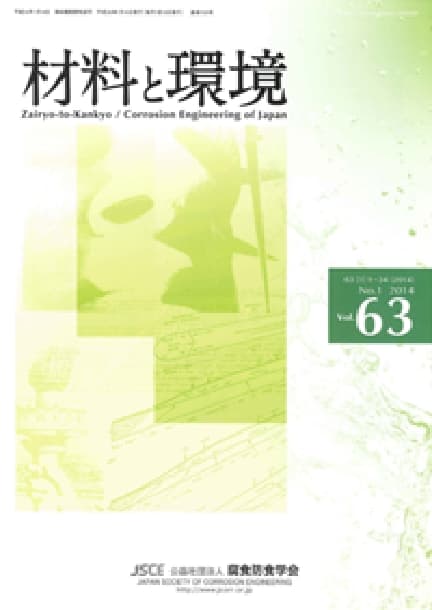材料と環境 Vol. 59 (2010), No. 1
Backnumber
-
Vol. 74 (2025)
-
Vol. 73 (2024)
-
Vol. 72 (2023)
-
Vol. 71 (2022)
-
Vol. 70 (2021)
-
Vol. 69 (2020)
-
Vol. 68 (2019)
-
Vol. 67 (2018)
-
Vol. 66 (2017)
-
Vol. 65 (2016)
-
Vol. 64 (2015)
-
Vol. 63 (2014)
-
Vol. 62 (2013)
-
Vol. 61 (2012)
-
Vol. 60 (2011)
-
Vol. 59 (2010)
-
Vol. 58 (2009)
-
Vol. 57 (2008)
-
Vol. 56 (2007)
-
Vol. 55 (2006)
-
Vol. 54 (2005)
-
Vol. 53 (2004)
-
Vol. 52 (2003)
-
Vol. 51 (2002)
-
Vol. 50 (2001)
-
Vol. 49 (2000)
-
Vol. 48 (1999)
-
Vol. 47 (1998)
-
Vol. 46 (1997)
-
Vol. 45 (1996)
-
Vol. 44 (1995)
-
Vol. 43 (1994)
-
Vol. 42 (1993)
-
Vol. 41 (1992)
-
Vol. 40 (1991)
キーワードランキング
12 Dec. (Last 30 Days)
材料と環境 Vol. 59 (2010), No. 1
耐候性鋼材の塗装による補修方法の検討
後藤 宏明, 守屋 進, 内藤 義巳, 山本 基弘, 藤城 正樹, 斎藤 誠
pp. 10-17
DOI:
10.3323/jcorr.59.10抄録
When weathering steels are applied to bridges located in the area with heavy contamination of salts or anti-freezing agents, some cases show generation of stratified loose rust layer on weathering steel in stead of intended protective rust layer formation. We studied repairing method of those weathering steels with undesired rust generation by painting. As a result, power tool cleaning is not effective enough to remove rusts with salts contamination.The remained salts in the rust affect performance of the repaired paint film and show unsatisfied anti-corrosive property.
沸騰硝酸溶液中のバナジウム及びクロムイオンの再酸化速度とステンレス鋼への腐食影響
本岡 隆文, 加藤 千明, 山本 正弘
pp. 18-24
DOI:
10.3323/jcorr.59.18抄録
The effect of chromium and vanadium ions on corrosion of stainless steels in boiling nitric acid solutions were investigated in terms of valence change with time. The corrosion behavior of type SUS304ULC stainless steel in boiling nitric acid solutions was investigated by corrosion test, measurement of corrosion potential and solution analysis. The formation rates of Cr(VI) and V(V) in boiling nitric acid solutions were also measured.
Cr(VI) more severely attacked the stainless steel than V(V). The concentration of Cr(VI) reduced with progress of corrosion and the oxidation ability of test solution weakened . While the concentration of V(V) was constant with progress of corrosion and the oxidation ability of test solution was maintained constant. In boiling nitric acid solutions, the formation rate of V(V) from reducdant was extremely faster than that of Cr(VI). In boiling nitric acid solution with V(V), the formation rate of V(V) was faster than the consumed rate of V(V) by corrosion of stainless steel. This caused the constancy of V(V) concentration and the steady corrosion of stainless steel. In boiling nitric acid solution with Cr(VI), the formation rate of Cr(VI) was slower than the consumed rate of Cr(VI) by corrosion of stainless steel. This caused the decreases of Cr(VI) concentration and corrosion rate of stainless steel.
論文アクセスランキング
12 Dec. (Last 30 Days)
-
大気腐食環境下における1700 MPa級調質ボルトの遅れ破壊機構
鉄と鋼 早期公開
-
Perspectives on the Promising Pathways to Zero Carbon Emissions in the Steel Industry toward 2050
ISIJ International Vol.65(2025), No.2
-
-
Factors Influencing the Bonding Phase Structure of Iron Ore Sinters
ISIJ International Vol.43(2003), No.9
-
-
-
Progress of Strip Casting Technology for Steel; Historical Developments
ISIJ International Vol.52(2012), No.12
-
Research Progress on Optimal Blending of Iron Ore Powders for Sintering
ISIJ International Vol.65(2025), No.12
-
-
Microstructures and Reduction Properties of High CaO Concentration Sintered Ore
ISIJ International 早期公開
この機能はログイン後に利用できます。
下のボタンをクリックしてください。










